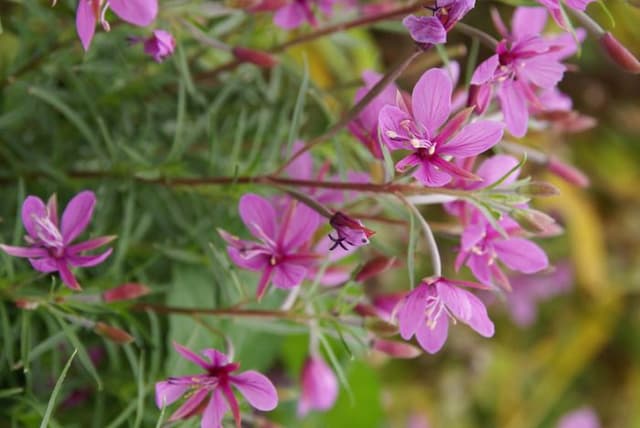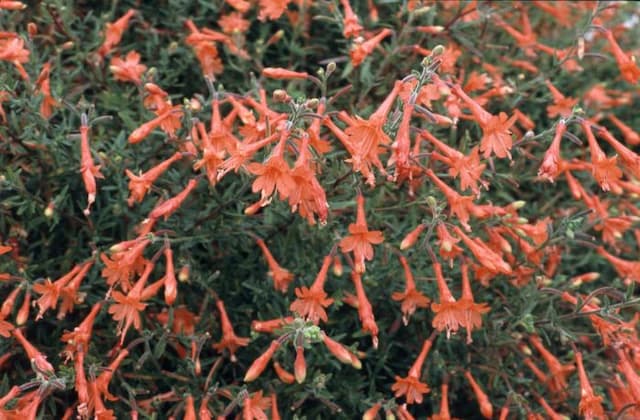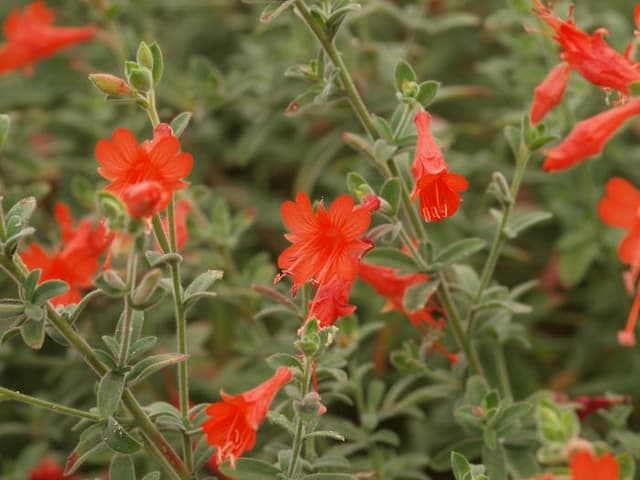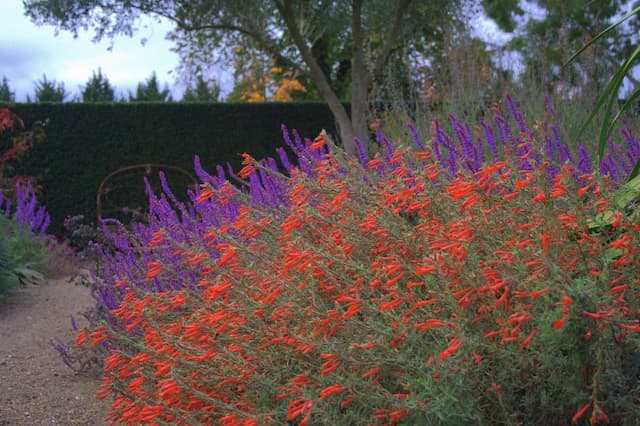Gaura Oenothera lindheimeri (G)

ABOUT
Oenothera lindheimeri, commonly known as the white gaura, is a perennial plant known for its airy and delicate appearance. It has long, thin, red-tinged stems that gracefully bear its flowering spikes. The plant is characterized by its long blooming period, displaying charming white to pink flowers that resemble butterflies dancing on the stems. These blossoms, which usually have four petals each, emerge from green or reddish buds. The white gaura's leaves are lance-shaped with a green to sometimes reddish hue, particularly when they are new or subjected to strong sunlight. Its foliage has a fine texture that adds a soft, willowy element to its overall form. The white gaura exhibits a bushy habit, with its stems and blooms creating an airy, fountain-like effect that sways attractively with the wind.
About this plant
 Names
NamesFamily
Onagraceae
Synonyms
White Gaura, Lindheimer's Beeblossom, Lindheimer's Gaura, White Wand Flower, Whirling Butterflies
Common names
Gaura lindheimeri, Gaura lindheimeri var. lindheimeri, Gaura lindheimeri var. leucantha, Gaura lindheimeri var. occidentalis, Gaura lindheimeri var. latifolia.
 Toxicity
ToxicityTo humans
Gaura, the most common common name for Oenothera lindheimeri, is not generally considered toxic to humans. It is not known to contain any substances that would pose a risk if ingested in normal quantities. As with any plant, individual sensitivities may exist, and it is always wise to exercise caution and avoid eating plants that are not specifically intended for human consumption. There is no widespread documentation of toxicity or symptoms of poisoning associated with this plant when it comes to humans.
To pets
Gaura, the most common common name for Oenothera lindheimeri, is also not generally known to be toxic to pets. It is not listed by major pet toxicity resources as a plant that is harmful to dogs or cats. However, it's always prudent to prevent pets from ingesting plants not intended for their consumption, as they might have individual sensitivities or allergic reactions. There are no specific symptoms of poisoning associated with pets ingesting Gaura, as it is not considered a poisonous plant in general.
 Characteristics
CharacteristicsLife cycle
Perennials
Foliage type
Semi-deciduous
Color of leaves
Green
Flower color
White
Height
2-3 feet (0.6-0.9 meters)
Spread
2-3 feet (0.6-0.9 meters)
Plant type
Herb
Hardiness zones
5-9
Native area
Texas Louisiana
Benefits
 General Benefits
General Benefits- Attracts Pollinators: Oenothera lindheimeri, commonly known as Gaura, is excellent for attracting bees, butterflies, and other beneficial insects that help pollinate nearby plants.
- Drought Tolerant: Gaura is highly resilient in dry conditions, making it suitable for xeriscaping and low-water gardens.
- Low Maintenance: This plant requires minimal upkeep once established, not needing frequent watering or fertilizing.
- Long Blooming Season: Gaura has a lengthy flowering period from spring to fall, providing extended visual interest in the landscape.
- Deer Resistant: Gaura is commonly recognized for its resistance to deer, which makes it an ideal choice for gardens in areas with high deer populations.
- Aesthetic Appeal: With its delicate, wand-like flowers that dance in the breeze, Gaura adds a whimsical charm to garden borders and flower beds.
- Erosion Control: The root system of Gaura helps stabilize soil, making it useful for planting on slopes or areas prone to erosion.
- Versatility in Garden Design: It can be used in a variety of garden styles, including cottage gardens, wildflower meadows, and contemporary landscapes.
- Temperature Tolerant: Gaura tolerates both high heat and humidity, performing well in a wide range of climate conditions.
 Medical Properties
Medical PropertiesThis plant is not used for medical purposes.
 Air-purifying Qualities
Air-purifying QualitiesThis plant is not specifically known for air purifying qualities.
 Other Uses
Other Uses- Gaura, the common name for Oenothera lindheimeri, can be used in xeriscaping, as it is drought-tolerant and thrives in dry, low-water landscapes.
- The flowers of Gaura are attractive to pollinators such as bees, butterflies, and hummingbirds, making it ideal for ecological gardens aimed at supporting these creatures.
- Due to its airy and graceful stems, Gaura is often used in floral arrangements as a filler to provide a delicate texture contrast to other flowers.
- Gaura's tall and slender form makes it a good choice for vertical accents in garden beds or containers, offering height without taking up too much space.
- The plant can be used as an informal hedge or border when planted in a mass, creating a light and whimsical partition in the garden.
- Gaura is also utilized as a ground cover in some garden settings, spreading out to fill space and suppress weeds with its foliage.
- As an erosion control plant, Gaura can help stabilize soil on slopes and banks with its root system.
- In moon gardens, designed to be enjoyed at night, Gaura's white blossoms can catch the moonlight and add a luminous quality to the landscape.
- Gaura is occasionally used as a living mulch; its foliage creates shade over the soil, helping to retain moisture and regulate temperature.
- Some gardeners use Gaura in sensory gardens, as the movement of its flowers and stems in the breeze can be quite mesmerizing and soothing to observe.
Interesting Facts
 Feng Shui
Feng ShuiThe Gaura is not used in Feng Shui practice.
 Zodiac Sign Compitability
Zodiac Sign CompitabilityThe Gaura is not used in astrology practice.
 Plant Symbolism
Plant Symbolism- Resilience: Oenothera lindheimeri, commonly known as 'Gaura', can thrive in tough conditions, symbolizing the ability to withstand adversity and bounce back.
- Beauty and Attraction: With its delicate white and pink blossoms, Gaura represents beauty and the power to captivate, much like the flowers themselves.
- Peace and Tranquility: Gaura's gentle appearance can be associated with calmness and serenity, making it a symbol of peace.
- Adaptability: Given its capacity to adapt to various environments, Gaura symbolizes flexibility and the willingness to adjust to new circumstances.
 Water
WaterGaura, commonly known as Whirling Butterflies, requires moderate watering. When the plant is young or newly planted, water thoroughly to establish a deep root system, about once a week, using approximately 1 gallon of water per plant, depending on weather conditions. Once established, Gaura is drought tolerant and needs less water, typically every two to three weeks. It's important to allow the soil to dry out between waterings. Overwatering can lead to root rot, so adjust your watering schedule according to the rainfall in your area and the soil's moisture level.
 Light
LightWhirling Butterflies thrive in full sun conditions, which means they need at least 6 hours of direct sunlight daily. The plant will perform best when placed in a spot that receives unobstructed sunlight throughout the day. If grown indoors, a south-facing window is an ideal location for Gaura to ensure adequate light exposure.
 Temperature
TemperatureWhirling Butterflies do well in a wide range of temperatures, but the ideal temperature range is between 60 and 85°F. They can survive brief periods of colder weather, down to about 20°F, but may not survive extended freezes. During summer heat, the plant is quite resilient, but it's best to provide some afternoon shade if temperatures exceed 90°F consistently.
 Pruning
PruningPruning Whirling Butterflies promotes bushier growth and can enhance flowering. Prune in late winter or early spring before new growth begins by cutting back the plant to about 6 inches above the ground. This helps remove old, woody stems and encourages fresh, vigorous growth. Deadheading, or removing spent flowers, can be done throughout the blooming season to encourage more blooms.
 Cleaning
CleaningAs needed
 Soil
SoilGaura, also known as Oenothera lindheimeri, thrives in well-drained soil mixed with compost and coarse sand, with a pH range of 5.5 to 7. A good mix might be one part garden soil, one part compost, and one part coarse sand or perlite. Ensure adequate drainage as Gaura does not like waterlogged roots.
 Repotting
RepottingGaura plants generally prefer being undisturbed, so repotting is rarely needed. Instead, they can be divided every few years during spring to manage their size and spread. If the plant outgrows its container, repot it in the spring using the soil mix as recommended above.
 Humidity & Misting
Humidity & MistingGaura plants are adaptable to a wide range of humidity conditions and do not require high humidity. They can handle the typical humidity found in most outdoor environments. Being native to dry areas, they actually prefer a drier climate which makes them well-suited for xeriscaping.
 Suitable locations
Suitable locationsIndoor
Ensure full sun, minimal water, and dry air.
Outdoor
Plant in full sun, well-drained soil, and space well.
Hardiness zone
5-9 USDA
 Life cycle
Life cycleOenothera lindheimeri, commonly known as White Gaura, begins its life cycle as a seed, often requiring well-drained soil and full sun to germinate effectively. Seedlings emerge and establish a rosette of leaves close to the ground before elongating their stems as they mature into the vegetative stage. During the vegetative stage, the plant develops an extensive root system and numerous stems with lance-shaped leaves. White Gaura enters the flowering stage in late spring to early fall, producing spikes of white to pink flowers that open a few at a time and attract pollinators for reproduction. After pollination, the flowers develop into small nutlets, which are the seed pods that will release seeds, completing the cycle. In colder climates, Oenothera lindheimeri behaves as a perennial, dying back to the ground in winter and resprouting from the root system in spring.
 Propogation
PropogationPropogation time
Early spring
Oenothera lindheimeri, commonly known as Gaura, is most popularly propagated through the division of its rhizomes or root masses. This method is best carried out in the early spring before new growth begins. By carefully digging up the parent plant, gardeners can gently separate the root ball into smaller sections, ensuring that each new division has a fair amount of roots and shoots attached. These divisions can then be immediately replanted in well-draining soil, ideally at the same depth they were growing previously. Water the transplanted divisions thoroughly to establish them in their new locations. This technique helps to maintain the vigor of the plant and also allows the gardener to multiply their stock efficiently.









